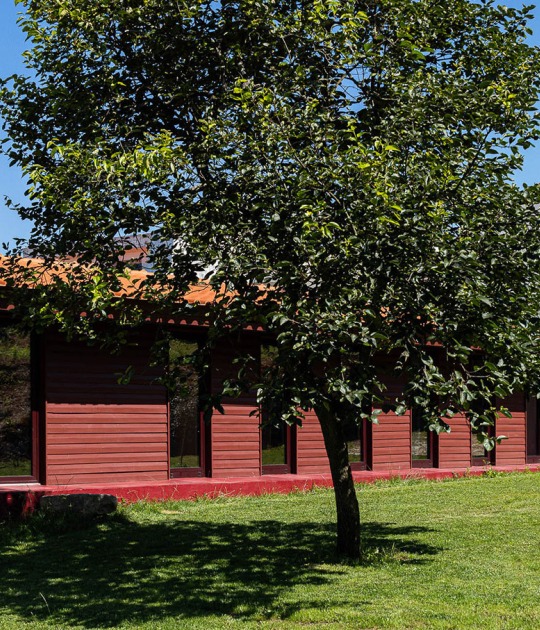MIRAG's project strategy was to build a building within another, modifying its original use while enhancing and respecting the building. The new proposal is located longitudinally with a corridor parallel to the south façade of the nave, which is understood as a rambla that gives access to the four wake rooms located in the central part of the nave and connected, in turn, with the technical corridor, parallel to the north façade, which gives access to the burial mound.
Upon entering the building on Comptes de Bell-lloc Street, the first thing you notice is a cylindrical volume of communications that gives access to the upper floor of offices and administration, and at the end of the nave, the double-height ceremony room that lights up from the back.
All the volumes, from the organic elements of the wakes to the office volume and the dome, with purer forms linked to spirituality, are built in wood, even the structure so that it can be dismantled in the future if necessary and be as sustainable as possible. Furthermore, it is all a uniform color to represent unity in the intervention and contrast with the wood of the roof.

Funeral home in the old Germans Climent factory by MIRAG. Photograph by Del Rio Bani.
Description of project by MIRAG
The project for this new Mortuary, located in the Sants neighborhood of Barcelona, is located inside an existing building, the old Germans Climent factory.
The building was built by the architect Modest Feu i Estrada in 1925. With a marked noucentiste style, it is an example of industrial architecture completely built with solid brick and with a unique roof of metal trusses and wooden joists. The volume has a rectangular shape with dimensions of 64 meters in length and 15.50 meters in width.
It is a protected historical building and is part of the Barcelona City Council's catalog of Cultural Assets of Local Interest.
The proposal arises from the premise of changing the use of the ship to build the program of a funeral home inside.

Funeral home in the old Germans Climent factory by MIRAG. Photograph by Del Rio Bani.
The intention of the proposal is to respect the original architecture of the building as much as possible and put it in value through the restoration of the existing building to return it to its original state, while at the same time making a proposal for a new use that is as respectful as possible to the past.
The strategy of the proposal is to build a building within a building.
The industrial warehouse becomes a container for the new funeral home building, with the wooden roof and its trusses acting as a protective sky and becoming the true protagonist of the architectural proposal.
The new building is located longitudinally along the nave, placing a promenade-like corridor parallel to the south façade of the nave, through which natural light and the sun enter. This arrangement allows the ship to be perceived in all its length and dimension.

Funeral home in the old Germans Climent factory by MIRAG. Photograph by Del Rio Bani.
The ramble gives access to the 4 wake rooms that are located in the central part of the body of the nave. At the back, on the north façade of Puiggarí Street, is the technical corridor that gives access to the burial mounds of the rooms and communicates with the technical rooms located at the back of the nave.
At the end of the nave is the ceremony room, which takes advantage of the space between the trusses to generate a double-height space that receives light from the upper part.
At the entrance to the building, located on Comptes de Bell-lloc street, the rounded communications core is placed that gives access to the first floor, where the offices and administration are located.
All the new volumes have been treated with a uniform light color that is used to define all the elements—walls, floor and ceiling—and that gives an image of unity to the entire intervention. In this way, a contrast is generated with the warmth of the wood of the cover.

Funeral home in the old Germans Climent factory by MIRAG. Photograph by Del Rio Bani.
The construction of the new elements is carried out entirely in wood, both the structure and the main finishes, so that the intervention can be dismantled in the future and is at the same time as sustainable as possible.
The walls of the wakes have sinuous lines and organic shapes that turn them into sculptures that seem temporary with the organic shapes that welcome the users.
On the contrary, the volume of the offices and the dome of the ceremony room are two geometric volumes that represent purer forms linked to spirituality.
With these decisions, the new building contrasts with the original nave without taking away all the prominence it deserves.

























































